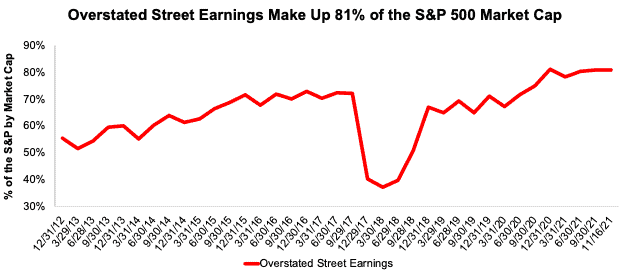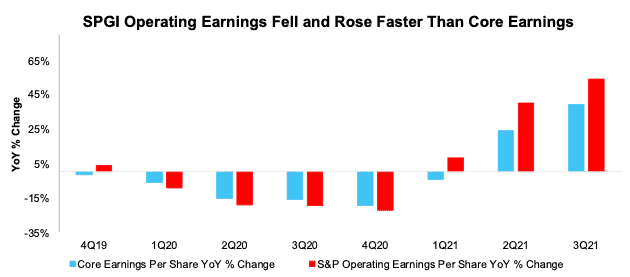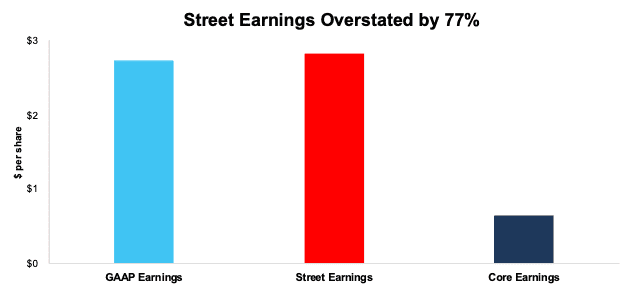Misleading earnings outperformance continued in 3Q21, increasing downside risk for the S&P 500. Operating Earnings from S&P Global (SPGI) exaggerated the drop in 2020 and have overstated the rebound in S&P 500 earnings through 3Q21. The same is true for Zacks Earnings (referred to in this report as Street Earnings), which are adjusted to remove non-recurring items using standardized assumptions from the sell-side.
This report shows:
- The prevalence and magnitude of overstated Street Earnings in the S&P 500
- Why Street Earnings (and GAAP earnings) are flawed
- Five S&P 500 companies with overstated Street Earnings and a Very Unattractive Stock Rating
- How Core Earnings[1] and our Earnings Distortion factor provide a new source of alpha
Nearly 200 S&P 500 Firms Overstate EPS by More than 10%
For 360 companies in the S&P 500, Street Earnings overstated Core Earnings[2] for the trailing-twelve-months (TTM) ended calendar 3Q21. When Street Earnings overstate Core Earnings, they do so by an average of 19% per company, per Figure 1. The overstatement was more than 10% of Street Earnings for 39% of companies.
Figure 1: Street Earnings Overstated by 19% on Average Through 3Q21[3]
Sources: New Constructs, LLC and company filings.
The 360 companies with overstated Street Earnings make up 81% of the market cap of the S&P 500, which is the highest percent since 2012 (earliest data available). See Figure 2.
Figure 2: Overstated Street Earnings as % of Market Cap: 2012 through 11/16/21
Sources: New Constructs, LLC and company filings.
S&P Global’s Earnings Rebound Is Misleading
In theory, equity analysts create adjusted earnings measures like Street Earnings and Operating Earnings to exclude unusual gains and losses. In reality, these adjusted earnings measures rarely, if ever, fully capture unusual items that have a material impact on results.
Per Figure 3 (from our report Overstated Operating Earnings Increase Downside Risk for the S&P 500), the rebound in earnings is not as robust as SPGI’s Operating Earnings suggest. Year-over-year (YoY):
- SPGI’s Operating Earnings improved from $123.37/share to $189.88/share, or 54%
- Core Earnings improved from $129.35/share to $180.31/share, or 39%
SPGI’s Operating Earnings for the S&P 500 were 5% below Core Earnings in 3Q20 and were 5% higher in 3Q21. Unusual losses included in SPGI’s Operating Earnings drive the exaggerated declines while unusual gains lead to the exaggerated rebounds.
Figure 3: Core Earnings vs. SPGI Operating Earnings: 4Q19 – 3Q21[4]
Sources: New Constructs, LLC, company filings, and S&P Global (SPGI). Note: the most recent period’s data for SPGI’s Operating Earnings is based on consensus estimates for companies with a non-standard fiscal year.
Our Core Earnings analysis is based on aggregated TTM data through 6/30/13 and aggregated quarterly data thereafter for the S&P 500 constituents in each measurement period.
The Five Worst Offenders in the S&P 500
Figure 4 shows the S&P 500 stocks with a Very Unattractive Stock Rating and the most overstated Street Earnings (Street Distortion as a % of Street Earnings per share) over the TTM through 3Q21. “Street Distortion” equals the difference between Core Earnings per share and Street Earnings per share. Investors using Street Earnings miss the true profitability, or lack thereof, of these businesses.
Figure 4: S&P 500 Companies with Most Overstated Street Earnings: TTM as of 3Q21
Sources: New Constructs, LLC and company filings.
*Measured as Street Distortion as a percent of Street EPS
In the section below, we detail the hidden and reported unusual items that distort GAAP Earnings for Equity Residential (EQR), one of the stocks in December’s Most Dangerous Stocks Model Portfolio. All of these unusual items are removed from Core Earnings.
Equity Residential’s (EQR) TTM 3Q21 Street Earnings Overstated by $2.17/share
The difference between Equity Residential’s Street Earnings ($2.82/share) and Core Earnings ($0.65/share) is $2.17/share, per Figure 5. That difference is the Street Distortion, which for Equity Residential is seventy seven percent of Street Earnings.
Equity Residential’s GAAP Earnings overstate Core Earnings by $2.08/share. Street Earnings are more distorted by unusual items than GAAP earnings for Equity Residential.
Figure 5: Comparing Equity Residential’s GAAP, Street, and Core Earnings: TTM as of 3Q21
Sources: New Constructs, LLC and company filings.
Below, we detail the differences between Core Earnings and GAAP Earnings so readers can audit our research. We would be happy to reconcile our Core Earnings with Street Earnings but cannot because we do not have the details on how analysts calculate their Street Earnings.
Equity Residential’s Earnings Distortion Score is Strong Miss and its Stock Rating is Very Unattractive. As noted above, Equity Residential is in December’s Most Dangerous Stocks Model Portfolio due to its overstated earnings and expensive valuation. Despite trading at $86/share, EQR has an economic book value (EBV), or no growth value, of just $10/share.
Figure 6 details the differences between Equity Residential’s Core Earnings and GAAP Earnings.
Figure 6: Equity Residential’s GAAP Earnings to Core Earnings Reconciliation: 3Q21
Sources: New Constructs, LLC and company filings.
More details:
Total Street Distortion of $2.08/share is comprised of the following:
Hidden Unusual Gains, Net = $0.01/per share, which equals $5 million and is comprised of
- $5 million in gains in 4Q20 to offset write-offs reported in prior 10-Qs but no longer disclosed separately in the 10-K
Reported Unusual Gains Pre-Tax, Net = $1.98/per share, which equals $766 million and is comprised of
- $767 million in gains on the sale of real estate properties in the TTM period based on
- $364 million gain in 3Q21
- $224 million gain in 2Q21
- -$43 thousand loss in 1Q21
- $180 million gain in 4Q20
- $27 million in interest and other income in the TTM period based on
- $1 million in 3Q21
- $24 million in 2Q21
- $216 thousand in 1Q21
- $2 million in 4Q20
- -$9 million in amortization of deferred financing costs in the TTM period based on
- -$2 million in 3Q21
- -$2 million in 2Q21
- -$2 million in 1Q21
- -$3 million in 4Q20
- -$20 million in “other expenses” in the TTM period based on
- -$3 million in 3Q21
- -$3 million in 2Q21
- -$4 million in 1Q21
- -$9 million in 4Q20
Tax Distortion = <-0.01/per share, which equals -$831 thousand
Reported Unusual Gains After-Tax, Net = $0.09/per share, which equals $34 million and is comprised of
- $34 million in gains in the TTM based on $34 million gain on the sales of land parcels in 2020
Given the similarities between Street Earnings for Equity Residential and GAAP Earnings, our research shows both Street and GAAP earnings fail to capture significant unusual items reported directly on Equity Residential’s income statement.
How to Make Money with Core Earnings & Earnings Distortion
As demonstrated above, Core Earnings do a better job of excluding unusual gains and losses and provide a more reliable earnings measure. All Core Earnings adjustments are 100% transparent; so users can audit and trust the research.
To enable you to easily monetize our new Earnings Distortion factor we present multiple trading strategies that drive alpha. Learn more below.
- ExtractAlpha presents a long/short market-neutral strategy that generates 9.3% annualized return net of Fama-French 5 factors, momentum, short-term reversal, and 12 sectors. More details here.
- CloudQuant presents two strategies to monetize the alpha in Earnings Distortion:
- the long-only portfolio outperformed the S&P 500 by an average of 4% per annum over 10 years
- the dollar-neutral long-short portfolio returned 60% over 10 years with a Sharpe Ratio of ~1 over the last five years. More details here.
- AltHub presents three strategies to monetize the alpha in Earnings Distortion:
- Earnings Distortion S&P 500 Smart Beta Portfolio: 10-yr annualized return of 13.9% vs 12.1% for the S&P 500 with a Sharpe Ratio of 0.97.
- Earnings Distortion ML Model S&P 500 Smart Beta Portfolio: 3-yr annualized return of 18.2% vs 13.7% for the S&P 500 with a Sharpe Ratio of 0.82.
- Truth Stocks (Companies without Earnings Distortion) Portfolios:
- S&P 500 Universe: 10-yr annualized return of 16.8% vs 12.8% for the S&P 500 with a Sharpe Ratio of 0.7.
- Russell 3000 Universe: 9.5-yr annualized return of 28.4% vs 12.6% for the S&P 500 with a Sharpe Ratio of 1.
- More details here.
This article originally published on December 10, 2021.
Disclosure: David Trainer, Kyle Guske II, and Matt Shuler receive no compensation to write about any specific stock, style, or theme.
Follow us on Twitter, Facebook, LinkedIn, and StockTwits for real-time alerts on all our research.
[1] Only Core Earnings enable investors to overcome the flaws in legacy fundamental data and research, as proven in Core Earnings: New Data & Evidence, written by professors at Harvard Business School (HBS) & MIT Sloan for The Journal of Financial Economics.
[2] Our Core Earnings research is based on the latest audited financial data, which is the calendar 3Q21 10-Q in most cases
[3] Average overstated % is calculated as Street Distortion, which is the difference between Street Earnings and Core Earnings.
[4] November 16, 2021, is the earliest date for which all the calendar 3Q21 10-Qs for the S&P 500 constituents were available.






